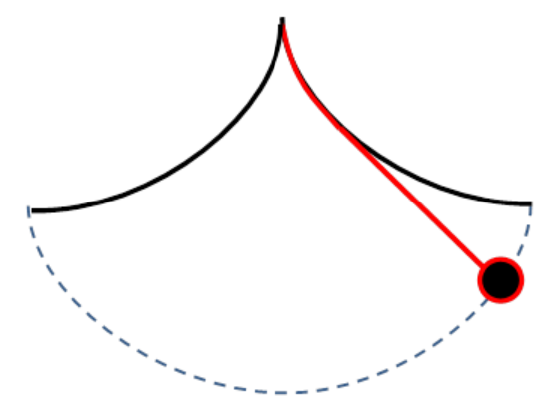2.6: The Perfect Pendulum
- Page ID
- 29528

Around the time of Newton, the best timekeepers were pendulum clocks—but the time of oscillation of a simple pendulum depends on its amplitude, although of course the correction is small for small amplitude. The pendulum takes longer for larger amplitude. This can be corrected for by having the string constrained between enclosing surfaces to steepen the pendulum’s path for larger amplitudes, and thereby speed it up.
It turns out (and was proved geometrically by Newton) that the ideal pendulum path is a cycloid. Thinking in terms of the equivalent bead on a wire problem, with a symmetric cycloid replacing the circular arc of an ordinary pendulum, if the bead is let go from rest at any point on the wire, it will reach the center in the same time as from any other point. So a clock with a pendulum constrained to such a path will keep very good time, and not be sensitive to the amplitude of swing.
The proof involves similar integrals and tricks to those used above:
\[T\left(y_{0}\right)=\int \frac{d s}{\sqrt{2 g\left(y-y_{0}\right)}}=\int \frac{\sqrt{1+y^{\prime 2}}}{\sqrt{2 g\left(y-y_{0}\right)}} d x\]
and with the parameterization above, \(y^{\prime}=\sin \theta /(1-\cos \theta)\), the integral becomes
\[\sqrt{\frac{a}{g}} \int_{\theta_{0}}^{\pi} \sqrt{\frac{1-\cos \theta}{\cos \theta_{0}-\cos \theta}} d \theta\]
As before, we can now write \(1-\cos \theta=2 \sin ^{2}(\theta / 2)\), etc., to find that \(T\left(y_{0}\right)\) is in fact independent of \(y_{0}\)
This is left as an exercise for the reader. (Hint: you may find \(\int_{a}^{b} d x / \sqrt{(x-a)(b-x)}=\pi\) to be useful. Can you prove this integral is correct? Why doesn’t it depend on a,b?)
Exercise: As you well know, a simple harmonic oscillator, a mass on a linear spring with restoring force \(-k x\), has a period independent of amplitude. Does this mean that a particle sliding on a cycloid is equivalent to a simple harmonic oscillator? Find out by expressing the motion as an equation \(F=m a\) where the distance variable from the origin is s measured along the curve.


